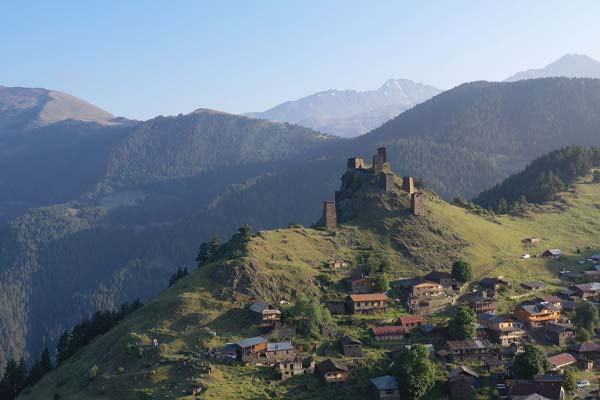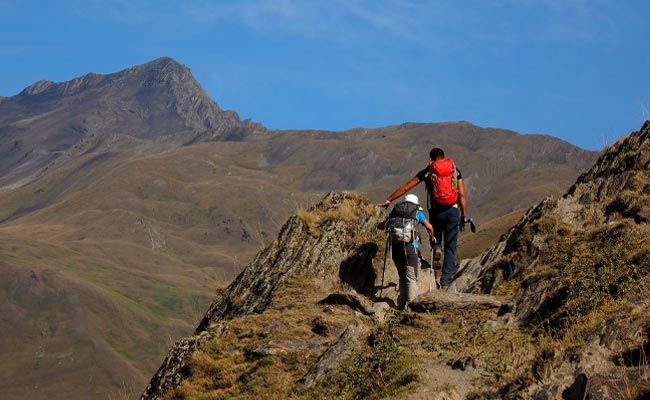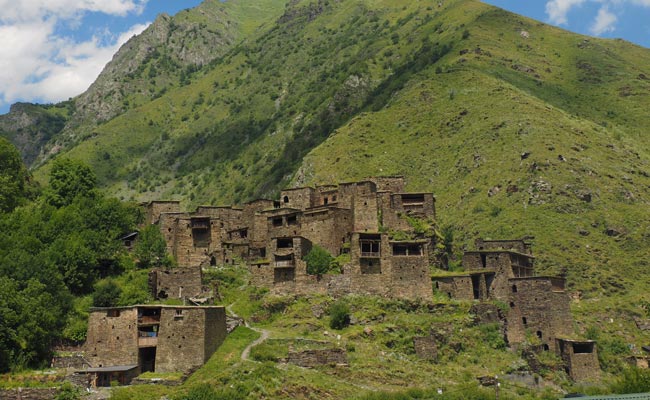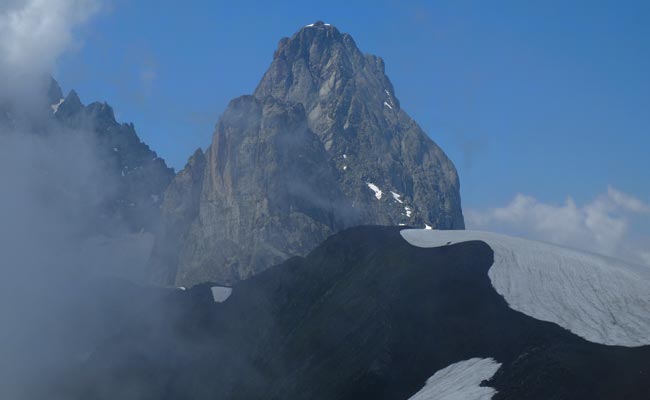|
Omalo in Tusheti Omalo is the administrative centre of the Tusheti region and is situated at about 2000 metres above sea level. The village is very popular because of its idyllic location, the fortified towers, the historic villages and the great hiking trails that surround Omalo. Not only hikers, but also cultural travellers have a lot to discover in and around Omalo, and although it is difficult to get there due to the road conditions, there is no shortage of visitors to the village. Location Omalo is located in the historical part of Georgia, Tusheti, about 100 kilometres north of Telavi, at an altitude of 1880 and 2080 metres above sea level. General information Omalo has three distinct neighbourhoods: Keselo, Old Omalo and Lower Omalo and a total of about 200 people live here in summer and only isolated families, 5 to 10 people stay here in winter. Omalo from Sky You can visit our YouTube channel and enjoy 4K footage of Omalo 1. Keselo - 18th century Keselo is the oldest and highest part of Omalo, at 2,080 metres above sea level. It is not possible to say exactly when the first towers or houses were built here, as no large-scale archaeological excavations have ever been carried out here and little written evidence has survived, but the defence towers that stand here today were built in the 18th century. Keselo stands on a small rocky hill to the north of Omalo. The small fortified village is protected from the west and north by the inaccessible steep valley of Alazani, from the south the slope is also relatively steep and the only access to the towers is from the east, which was also protected by a fortified wall. Nothing remains of the wall today. Keselo originally consisted of 13 towers, but today only 6 remain, and they are all relatively close together. The towers of Keselo are different in form and function from the towers of Svanetia. The defence towers in Keselo were only used for defence against external enemies, not for avalanche protection, nor did they have any symbolic status and were not used to fight other families or neighbours. The defence towers in Keselo are made of slate and have a square shape of approx: 5.4 by 4.5 metres. The walls are 60 cm. wide and 8 to 10 metres high. The towers have entrances from different sides and the floors inside the tower are two to four. The floors could be reached by a wooden ladder, which could also be retracted. The defensive walls have embrasures on each side and a flat roof. The reason for the construction of such facilities was the increasing number of surplus furs from the North Caucasus. Free fighters, mainly from Dagestan, but also from Chechnya, often invaded Tusheti in small groups and took everything they could, not only women or children, who were later sold for a lot of money in the Ottoman Empire, but also livestock and even household items, simply everything that had any materialistic value. No people live here now, but for over a hundred years the defensive towers of Keselo served the inhabitants as a safe shelter against raids from the North Caucasian irregulars, but Keselo was never a permanent place of residence, the towers being built so that one could retreat there for several days in the event of a siege. 2. Old Omalo - 18th to 19th century. The Old Omalo, or often called Upper Omalo, is situated a few metres below Keselo at an altitude of 2.050 metres. The first houses, some of which are still standing today, were built in the 18th and 19th centuries, and this is where the inhabitants mainly lived. They only went into the towers of Keselo, above the village, in the event of a siege. Originally there were about 10 houses in this part of the village, but now there are about 50 shelters. Most of the new houses are also built in the old style, with shepherd's stone and thatched roofs. Unlike Keselo, Old (Upper) Omalo is inhabited, with 50 to 100 people living here in the summer. It is uninhabited in the winter. 3. Lower (New) Omalo - 20th century Lower Omalo, also called New Omalo, was built in the 20th century during the Soviet era and is situated at an altitude of about 1880 metres. The houses here are built in a variety of styles, some of them, as in other regions of Georgia, two storeys high, often with a small balcony and tin roofs. Occasionally you can see houses built in the old style, but these have only recently been built. In New Omalo you can also see the foundations of old buildings from earlier times, and it is thought that the people of Omalo had winter houses here, which makes sense because the village is relatively low on the southern side and gets a lot of sunlight. In winter, the high snow levels meant that they were not in danger of being raided from the North Caucasus. There are about 50 houses in the village and 100 to 150 people live here in the summer, while 2 to 3 families live here in the winter. Where do the people of Omalo go in winter? In the Middle Ages, the inhabitants of Tusheti in general were given winter pastures by the Georgian kings in the village of Alvani (in Kakheti), where they later built their houses and lived during the winter season. Nowadays, the houses of the Tutsi in Alvani are also inhabited during the summer, as not all members of the family go to Omalo during the summer season. Electricity in Omalo In Omalo, as in Tusheti in general, there are no electricity lines. The villagers have photovoltaic cells, which they use to generate electricity and heat water. The cells are relatively small, however, and are only partially sufficient for household and daily use. School, nursery and hospital in Omalo There is no school or kindergarten in Omalo because children in Georgia have a 3-month summer holiday and return to the valley with their families at the end of the summer anyway. There is a small hospital in Imalo, however, where medical care is relatively good, and they have all-terrain ambulances that can travel to neighbouring villages. There is a helicopter for emergencies in the mountains, but it comes from Telawi in the valley, not Omalo. Transport to Omalo There is no public transport to Omalo, but there are private off-road taxis from the village of Kwemo Alwani, 25 kilometres north of Telavi, which offer a ride to Omalo for about 150 euros (per car). The cars are spacious and fit 4 to 6 people. Otherwise, there are numerous companies, including German-speaking travel agency Enjoy Georgia, that offer a ride from Tbilisi, or any other place in Georgia, to Omalo and back to Tbilisi. The journey from Telavi to Omalo takes about 4 hours, although it is only 100 kilometres. From Tbilisi directly to Omalo takes about 7 hours and depending on which way you take it is 200 to 250 kilometres. Road to Omalo The road to Omalo is not as bad as some blogs describe, but it is bad enough not to drive it yourself. About 50 kilometres section over Abano Pass (2,850 metres) is steep, narrow, was never tarred, there are several sharp curves, there are always stones coming round, there are no safety barriers on the "road" and you have to know your way around to reverse in case someone is coming towards you and you have to swerve. Otherwise, the road is quite ok. You definitely need an off-road car with the four-wheel drive and ideally a driver who has driven the road several times. It may be helpful to know that there are no petrol stations at the top and you should fill up in Telawi. The road to Omalo is cleared in mid-May and remains open until October, but during bad weather the road is closed and it sometimes takes several days before it is cleared again. This means that if you want to get to Omalo even in August, the road could be temporarily closed depending on the weather. Hiking routes in Omalo There are several easy, moderate and difficult hiking routes in the Omalo area. The most popular of these are: 1. hiking from Omalo to Dartlo Accommodation and Cafes There are several guesthouses in both Upper and Lower Omalo. The accommodation is comfortable and clean, with shared showers and toilets, and some have rooms with their own bathrooms. The nice thing about the accommodation is that you can get local food, so you don't have to worry about bringing extra food. A night in Omalo costs around 25 euros per person, including breakfast and dinner. There are a few cafes and a bakery in Old (Upper) Omalo. Shopping in Omalo There are no real shops in Omalo, but you can buy small snacks in the small cafés. You should do some real shopping down in Kakheti before going to Omalo. It's good to know that you can only pay in cash in Omalo and there are no ATMs. Camping in Omalo There is no proper campsite in Omalo, but there are plenty of places near the village where you can camp for free. On following trip, you will visit Omalo Hiking Omalo to Stepantsminda >> from 1,850 EUR
|






